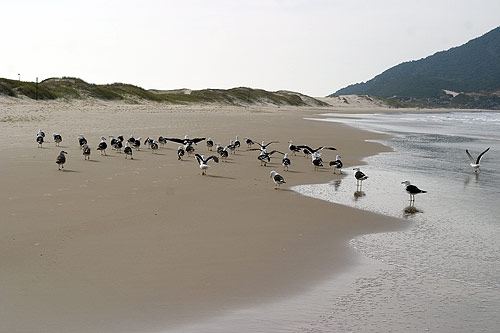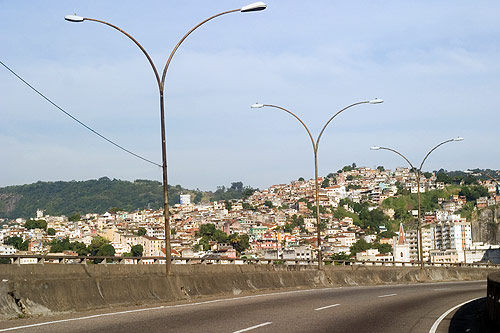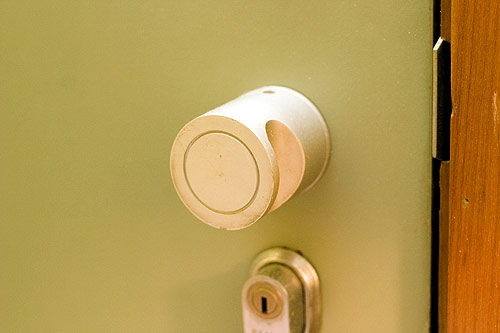Remember my trip to Brasil in May? Yeah, I remember it like it was yesterday… I’ve been overwhelmed with photos ever since my return, but wanted to give you a few morsels. Here are a few photos. I’ll post more soon.

Rio de Janeiro at sunset (this is the lagoon that is half salt water and half fresh water). Very similar to this photo I took on Victoria Island last year.

Floripa is a resort island / village with some nice resorts and dunes. Cool place.

Also from Floripa, and this is the beach.

This is what a favela looks like. There are over 500 of them in Rio de Janeiro.

Door handle down in Brasil.
I took my Moleskine notebook with me to Brazil and captured about eight pages of notes about random things I thought about. I decided to share them with you. Here’s the first two pages.
- We boarded an airplane in Floranopolis without even showing our identity or passport. Just gave them our tickets and we were set to go. Freaky.
- A neat name for a skydiving company would be “Golden Parachute.”
- Airplane headrests are too high. It’s really difficult to fall asleep when you can’t put your head back into a resting position. I only saw one airplane that actually had decent headrests the whole trip.
- MythBusters should find out if 30% of your body’s heat is really lost through your head. This just can’t be true.
- I saw an exact duplicate of Wheel of Fortune except it was in Portuguese. Amazing, too, was the fact that I couldn’t understand any of the letters and vowls. The contestants would say one thing, and I heard something totally different.
- Rio de Janeiro means “River of January.” It was discovered on January 1st and entered in a ships log book.
- Rio de Janeiro has a lagoon that is half salt water, and half fresh water. This means that different types of fish exist in the same lake, but at separate levels.
- The Brazilians believe it was a Brazilian that invented the airplane.
- Brazilians eat a lot more mango, pinapple, and coconut than we do.
- I saw only one wifi spot in Brasil that was reasonably priced. It was an Apple iCafe (not sure if it was official) in downtown Rio de Janeiro, near Copacabana Beach. In US dollars it was about $1.25 for 15 min.
- Millions of people live in favelas which are slums. The people that live in them go to work in the city and work in hotels, restaurants, and everywhere in between.
- The voltage in Rio de Janeiro is 110v and 220v. In Floripa it is mostly 220v.
- Interesting things to eat: quail eggs, duck, mango, ravioli filled with brie cheese, shrimp, oysters.
- Why do horses need shoes and what other domesticated animals might need shoes?
- While in Rio de Janeiro I had a really good Churro… also referred to as Brazilian Donuts… hot caramel injected into a type of sugary bread. Most excellent.
8 responses to “Brasil Notes #1”
Now Im realy curios about the other 6 pages.
Just some few points that should be explained.
You are usualy asked for identity when boarding in airplanes.
Yes, we HUMANS lost a lot o heat (and water) through our heads. *(why the people in desert cover their heads…)
And, yes, I did realy invented the Airplane. Santos Dummont did it here and constructed the plane in France where happened the first “OFFICIAL” flight. Everybody agrees…
but thats just fine. nice blog indeed…
The trick is, Santos Dummont from what I understand didn’t invent the first sustained flight. I think he flew across a field. The Wright brothers actually made everything work together.
Thanks for stopping by Patrick.
Here’s more about the flying guy. Apparently there’s controversy over who flew first. http://en.wikipedia.org/wiki/Santos_Dumont
I love the pictures and would like to see more. Don’t know exactly why horses are shod, but I do know that dogs like to eat the old padding between the hoof and the shoe as a farrier works on reshodding. More on horsefeet protection here: http://www.horseshoes.com/
How’d you eat the shrimp?
Santos Dumond made the first flight indeed! With proof. He fight more time, before the bothers and have real documents. The bothers just dont have valid documents but what can do if some people only dont acccept they are not the best in EVERYTHING!!
Hi!
I’m brazilian and Santos Dummont invent the the first Airplane!!
Santos Dummont didn´t invent the airplanes. He developed an airplane, named 14 Bis, that for the first time took off, flew over Bagatelle fields (in France, close to Paris) and landed, only with the power of its own engine. All these facts were registered by the french press, even all the action was recorded. The fact was registered in France airclub that time. Before this flight, Santos Dummont also developed many driveable baloons, breaking records of distance and speed limits. What is known about the Wright Brothers´ flight is that their airplane didn´t took off by itself – it was thrown in the air by an artifact like a slingshot in a down slope an made a short flight. They made no registers about the flight, only a picture of beside the airplane, on the ground… and it was after the flight of Santos Dummont.
Who designed and flew the FIRST practical airplane?
http://www.airshowfan.com/first-airplane.htm
As I release the latest version of my website, Brazil is celebrating what it considers to be the “Centennial of Flight”. As of October 2006, it has been one hundred years after the flight of what Brazil considers to be the first airplane, the 14-bis, a machine designed and flown by the man Brazilians call “the father of aviation”, Alberto Santos Dumont.
Most Brazilian people explain hostility at the idea that the Wright brothers were the first to fly; Most Brazilians are certain Santos Dumont was first, although they won’t be able to explain why. And pretty much everyone else in Brazil does not really understand what the controversy is about either, but is honest enough to therefore not have a strong opinion on the subject. So this page is an attempt to clear up this confusion.
In this essay I will spare you the biographical notes on Santos Dumont and on the Wrights. While they led very interesting lives, and while the paths they took in developing aeronautical technologies were long and fascinating, these details are irrelevant to the issue being discussed here. Which was the first practical airplane: The 14-bis or the Flyer?
This controversy is, in reality, only a debate over how to define “first practical airplane”. Is it more important that a “practical airplane” be able to fly controllably for long distances and at altitudes higher than most trees and buildings, or that it be able to take off unassisted from a flat surface without the benefit of a rail or ground acceleration device? That’s what the controversy comes down to. The Wright flyer flew first, it could fly for dozens of miles at altitudes well above any tree or building. However, it was not shown to be able to take off unassisted (from a large flat surface, rather than from a cumbersome launch apparatus) until 1908. The 14-Bis could take off from a flat level surface, but it could barely fly high enough to avoid spectators (4 meters) and never for more than 10 minutes. So which is the “first airplane”, the “first practical airplane”, the “first heavier-than-air flying machine”? It’s up to you to formulate your own definition, and thus to arrive at your own answer.
Most people in Brazil apparently place more importance on the ability to take off unassisted than on the ability to fly for long times and distances at high altitudes. And that’s a perfectly legitimate way of looking at it. Santos Dumont was the first to demonstrate an unassisted takeoff, and (if you want) that can be the end of the story.
However, if you want to look at the other aspects of the “controversy”, you will probably find that the Wrights’ achievements have been unfairly questioned and ignored by most Brazilians. So let me just explain what the Wrights did, so that a Brazilian reader can understand why the Flyer could reasonably be defined as “the first airplane”, despite the fact it did not take off unassisted until after the 14-Bis did.
Many Brazilians think that the Wrights always tested secretively and in secluded locations, therefore the dates of their tests can’t be verified, and their claims to have flown before Santos Dumont might be one big lie. This is not quite true. There are two nuggets of truth here: One is that the Wrights asked that the media not come to their 1903 test-flights in KittyHawk. This was so that they could officially announce the success of their flights from Dayton, their home town. The other nugget of truth is that only a handful of people attended the 1903 flights. The Wrights did tell the residents of KittyHawk about the experiments, and urged them to come watch on the dates the Flyer was tested. However, only a handful of people lived in KittyHawk at the time, so really it should be no wonder that few people witnessed the December 1903 tests. So yes, KittyHawk was somewhat secluded, but it is very probable that the Wrights chose it not for its remoteness, but for its steady winds (which made flights easier as the Flyer could take off into air that was already moving past it at some speed). Most subsequent tests were carried out in a field near Dayton, Ohio (an area that eventually became Wright-Patterson Air Force Base), and each time the Wrights thought they had some major bug fixed, they would invite many people to come, including the press. For example, hundreds of people did attend the demonstrations made on October 4 and 5, 1905, during which Wilbur managed to keep the Flyer in the air for 39 minutes, completing 30 laps around the field for a total of 24 miles. So you need to be quite the conspiracy theorist to doubt the abilities of the machines that the Wrights were flying in 1905.
It may also be worthwhile to point out that, while the Wright Flyer could be fown for over 39 minutes in 1905, the 14-Bis never did fly for more than one or two minutes, and while the 14-Bis could only fly about 5 meters off the ground (maybe 10), the Flyer could fly higher than any tree, building, or hill in the area. The Flyer was also arguably much more controllable: It could climb, descent, make controlled turns towards a desired heading, be flown through figure-8s… In short, it could do almost anything that a modern light airplane can do. The 14-Bis was barely controllable (it had a hard enough time flying in a straight line) although Santos Dumont’s subsequent aircraft were more capable. Still, by 1908 the Wrights were flying for over two hours at a time, but Santos Dumont never managed to make an airplane with an endurance of over 10 minutes. (Incidentally, some people think that Santos Dumont flew the 14-Bis around the Eiffel Tower. This is false. He did, however, fly his Number Three dirigible around it several times on its very first test flight in November of 1899. Then, in October 1901, he flew the far superior Number Six dirigible from Saint-Cloud around the Eiffel Tower and back in under half an hour, which won him the Deutsch Prize to much fanfare all over France and Brazil. His dirigibles could stay in the air for long periods of time and flew several hundred meters high, but they did not have the speed or agility of an airplane.)
Despite the practically-indisputable facts that the Wrights flew first and that their airplane was quite superior in the air, the fact is that Santos Dumont was the first to take off unassisted. Since this really is the only point that Santos Dumont fans have while stating the superiority of his aircraft, let me talk just a little bit about the Wrights’ launch apparatus.
Like I said, most people in Brazil apparently place more importance on the ability to take off unassisted than on the ability to fly for long times and distances at high altitudes. And that’s a perfectly legitimate way of looking at it. Really. In fact, it is the official way of looking at it, technically. The French organization that still today keeps track of aviation records also thinks this way, and refused to give an altitude record over to the Wrights, explaining that they had not taken off unassisted, a requirement for any record. This happened in 1908, at which point the Wright brothers did perform an unassisted takeoff in the Flyer, just to show they could. Well, sorry, Santos Dumont did it first.
(Note that this requirement for an official record also strips away the records made in the X-1, X-15, X-43, and SpaceShipOne, as all of those were dropped from larger aircraft and thus could not have broken their respective records if they had to take off unassisted from a runway. This is why the “official” speed record is held by the Lockheed SR-71, and the altitude record by the unmanned NASA Helios, as those aircraft could take off and land unassisted and still break those records).
If the Flyer could take off unassisted, why hadn’t it up until that point in 1908? And, really, could it take off unassisted in the slightly inferior version being flown in 1903 and 1905?
First of all, the fact is that all early aircraft were quite underpowered, and required a long take-off roll to get off the ground (assuming they could get off the ground unassisted at all). Many would-be aviation pioneers saw their aircraft badly damaged when take-offs were attempted, as wings struck the ground or as wheels and other structures broke when bumps were hit. In fact, a bump on the field could cause the airplane’s nose to drop and hit the ground, a most unfavorable kind of accident experienced by some taildragging aircraft even today. So, really, it’s quite understandable that the Wrights chose to launch their aircraft off a rail.
And if you have to make a rail and put the airplane on it, you might as well have a mechanism in the rail that pushes the airplane forward a little bit. THAT is what a “catapult” is, NOT one of those medieval siege weapons that hurled projectiles through the air. Many Brazilians think that the “catapult” used by the Wrights was this kind of projectile launcher. It is hard to not laugh at the idea. If that were the case, then the first flight could have occurred around 300BC, if only anyone had bothered to ride the boulders being flung by those machines…
The catapult mechanism the Wrights had consisted of a tower with a weight hanging from a cable. As the weight fell from the top of the tower to the bottom, it pulled the cable. The other end of the cable wound around the front of the launch rail and into the base of the airplane, pulling it forward. So the “catapult” was simply a device to help the Flyer reach flight speeds – and it clearly could maintain those flight speeds for quite a while once it was off the ground.
The question is, could the Wright Flyer have reached those flight speeds on its own, while dealing with draggy, slow, high-angle-of-attack flight, or with friction with the ground? In other words, could it take off? Well, it did in 1908. But refinements were constantly being made to the Wrights airplanes, so it is easy to argue that the Flyer could not have achieved this feat in 1903, since in 1903 it could barely get off the ground while being catapulted into a steady wind! (In fact, an exact replica of the Flyer failed to fly at KittyHawk in 2003 when the organizers of the Centennial Of Flight celebrations tried to reproduce/reenact the Wrights’ historic flight). It is also possible to argue that the Wrights probably could not have done it in 1905, but who knows. This is where things get into impossibly tricky “What if” areas. The only thing we can know for sure is that the Wrights did not demonstrate an unassisted takeoff until 1908, well after Santos Dumont did. In fact, it was only in 1909 that the Wrights caved in to market pressures and added wheels (rather than skids) to their airplanes.
An interesting first-hand source regarding this whole issue of the practicality (or lack thereof) of the catapult is a letter written by Wilbur Wright himself to French Army Captain Ferdinand Ferber, part of which says:
“We had already seen by the picture in the New York Herald that the plane rests on three wheels and we deduce from this that Mr. Santos Dumont, in order to effect his take-off, has first to make a run over a long level field. With the aid of the starting-off pillar that we use, Orville and I speedily go right up into the air in a much more practical fashion… We are sure to find a lot in our favor if we come to exhibit in France; but the voyage and the transportation of the machine and the pillar cost much more money than the two poor mechanics can afford to spend; also, dear Captain Ferber, if French experts, under your management, desire to come to Dayton, we will give them a demonstration of the machine in a neighboring field, flying for five minutes in a complete circle…”
From this passage, Santos-Dumont fans could infer that the Wrights’ take-off apparatus made their aircraft overly impractical to operate and transport. Alternatively, Wright brothers fans could point to the implication that the scarcity of usable takeoff fields made the Flyer and “pillar” more practical, needing much less open, smooth and level space than the 14-bis required to take off. Which is less practical: An airplane that needs a long field to take off, or one that needed some cumbersome launch apparatus? That’s up to you.
So Santos Dumont was the first to demonstrate an unassisted take-off. At that time, the Wrights were flying for over half an hour over dozens of miles and performing turns at fairly high altitudes, while the 14-Bis could not fly higher than 4 meters off the ground and had extremely limited controllability (and no Santos Dumont airplane could fly for longer than 10 minutes even when the Wrights flew for over two hours). Who was first? Depends on your definition.
In the end, it is patriotic pride that so heavily fuels debate over the relative importance and practicality of each aircraft. Naturally, most Americans prefer the definitions that make the Wrights the “first” to fly, while most Brazilians believe the definitions that cause Santos Dumont to have had the first “real”, practical airplane. Many Brazilians may also feel that Santos Dumont’s nationality may have caused his accomplishments to not receive the worldwide recognition they are due.
I hope this helps to clear things up a bit. It’s silly to debate the definition of a practical airplane. I mean, honestly, neither aircraft was really that practical…
Let me end this essay by noting that many other inventions could also claim the title to the first flying machine. From powered, heavier-than-air, but less-than-controllable airplanes, to gliders and balloons, a long series of “flying machines” separately achieved many of the individual criteria that are required of an “airplane”. These achievements, most of them first accomplished in the 1800s, include being able to sustain flight (albeit only lighter-than-air flight at first), using thrust to move wings through the air so as to generate enough lift to rise off the ground (albeit not controllably at first), and creating a winged vehicle that can stay in the air for more than a few seconds and that can be controlled to turn, dive, climb, etc (albeit at first only gliders that required a loss of altitude to “power” them). For example, Frederick Marriott’s Avitor was a slightly-heavier-than-air dirigible that was fully controllable. It relied primarily on a large hydrogen gas bag for flight, but it had wings and it could only get off the ground by moving forward so that the wings generated the additional lift needed to overcome its weight. Could such a hybrid be “the first heavier-than-air flying machine”? It is only one of many examples of a long history of flying contraptions, so this debate could easily be extended well beyond being about simply the 14-Bis versus the Wright Flyer.
But that’s another story.
– Bernardo
AirShowFan@Gmail.com